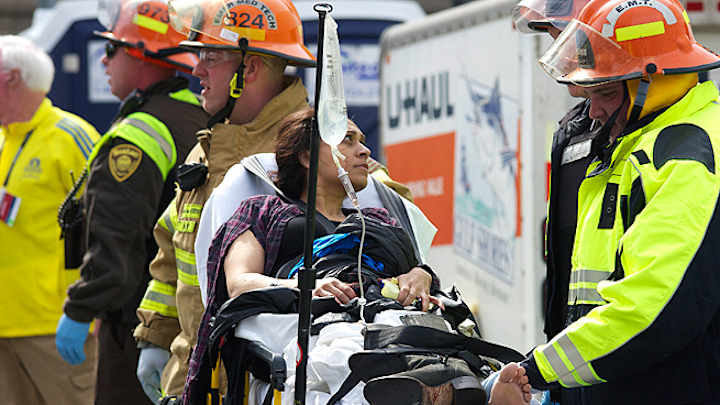Metal and sharp objects removed from bombing victims' injuries


A dark-haired little girl arrived with singed eyebrows, nails sticking out of her and a badly damaged leg. A little boy also was full of metal fragments, one of his legs bound by a tourniquet that saved his life. A day later, the injuries from the Boston Marathon explosions are now more of a threat to limbs than to lives, doctors and hospitals report.
Three people were killed and more than 170 people were injured by two bombs that were reportedly packed with pellets, nails or metal shards. Dozens remain hospitalized with broken bones, shredded muscles and head injuries. At least a dozen people lost one or more limbs from blasts that doctors say are typical of war zones and leave combat-style injuries. And some described horrific scenes, such as seeing a severed foot on the pavement.
Investigators found fragments of BBs and nails, possibly contained in a pressure cooker used to make the explosives. Doctors' accounts reflected that description.
"We've removed BBs and we've removed nails from kids. One of the sickest things for me was just to see nails sticking out of a little girl's body," said Dr. David Mooney, trauma chief at Boston Children's Hospital, which treated 10 blast victims, including a pregnant woman later transferred to another medical center.
Mooney at first doubted the emergency call to prepare for many seriously injured patients. Then he saw the 10-year-old boy with the badly injured leg.
"My first thought was, `He's really hurt. This isn't just some EMS overcall,"' Mooney said. "Someone at the scene put on a big tourniquet. He had singed hair, singed eyebrows, soot all over his face."
The 9-year-old girl also was in bad shape and singed. "Whoever got to her first saved her life" by putting on a tourniquet, Mooney said. "If they hadn't done that, she would have died."
Fast work by emergency responders no doubt saved many lives, doctors at many Boston area hospitals said. The blast occurred near the marathon's finish line where medical tents were set up to care for injured or tired runners.
People at the scene used different things as tourniquets, including lanyards with marathon credentials many wore around their necks. Some police officers gave their belts, said Dr. Martin Levine, a New Jersey family physician who was one of the doctors being paid to help elite athletes recover after they finish the race.
Levine told of a woman whose right leg was severed at her right thigh, leaving the femur bone sticking out, and of seeing a severed foot on the ground and not knowing whose it was.
"I've never seen an explosion where people's bodies explode and I hope I never see it again," he said
When word of mass casualties reached Tufts Medical Center, "we stopped all elective surgery in the operating room" in order to free up rooms to treat blast victims, said Dr. William Mackey, the hospitals' surgery chief.
Doctors removed many odd-shaped pieces of metal ranging up to half an inch in size, with nurses saving and tagging them for waiting police investigators.
"One woman from the blast had a piece of a zipper, a handle of a zipper embedded in her ankle joint, which is indicative of the force of the explosion," he said. Of the 19 blast patients, 10 remained at the hospital as of midday Tuesday.
At Beth Israel Deaconess Medical Center, Dr. Stephen Epstein said he saw an X-ray of one victim's leg that had "what appears to be small, uniform, round objects throughout it - similar in the appearance to BBs."
The hospital treated 24 patients, including three amputations. As of Tuesday morning nine patients had been sent home.
Doctors at Massachusetts General Hospital treated 31 victims. The hospital performed four amputations and at least two more patients have legs that are still at risk of amputation, Dr. George Velmahos said.
At Boston Medical Center, the trauma chief, Dr. Peter Burke, said 19 of the 23 blast victims it treated remain hospitalized, 10 in critical condition. Five patients have lost one or more limbs.
"Some of those 10 are pretty sick" and may yet wind up needing amputations, he said. A lot of them are kept on life-support for multiple operations, but the staff expects and hopes all will survive, he said.
An orthopedic trauma surgeon there, Dr. Paul Tornetta, described pellets and metal shards in many wounds.
"This is very high energy, high velocity shrapnel and blast injuries ... very similar to what a hand grenade might do," he said.
Many of the injuries sound similar to those caused by IED attacks in Iraq and Afghanistan, said Dr. Andrew Pollak, chair of an American Academy of Orthopedic Surgeons' war injuries project. Pollak, an orthopedic trauma surgeon at the University of Maryland, said he's heard about the injuries from colleagues in Boston. Improvised explosive devices are often packed with nails, ball bearings and sharp pieces of metal designed to inflict severe injuries. Blast victims face a huge risk of infection because of debris that gets imbedded in tissue, Pollak said.
